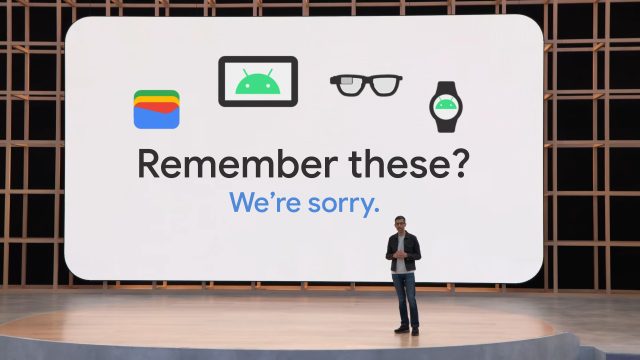
When 2022 dawned, there were a few things we knew we would be writing about: The global pandemic, whatever cool things Apple and Google did, rocket launches, and cool artificial intelligence stuff. But every year offers surprises, and 2022 was no exception.
Yes, we figured there would be plenty of articles about Elon Musk on Ars Technica this year. After all, he runs SpaceX and Tesla, two companies we frequently cover. But if someone told me Musk would become "Chief Twit" and end up all over the front page of Ars due to his impulse purchase of Twitter and the... interesting decisions he's made since taking control of the company, I would've asked them to pass the dutchie on the left-hand side.
2022 has been a long, strange trip. And it's almost over.
So let's look back at what you, our readers, found the most fascinating on Ars this year.
20. Google’s past failures were on full display at I/O 2022

Google is arguably known for three things: absolutely dominating the Internet advertising market, absolutely dominating the Internet browser market, and absolutely dominating the killing-your-own-products market. At Google I/O 2022, the company decided to engage in a bit of device necromancy. Case in point: Android tablets.
The pinnacle of Google's Android tablet development was in 2011, when we saw the release of Android 3.0 Honeycomb. I'll let Ron Amadeo take it from here:
"[E]very subsequent Android release and Google app update watered down the tablet interface until it disappeared. App developers took Google's neglect as a sign that they should stop making Android tablets, too, and the ecosystem fell apart.
"After the 2015 Pixel C release, Google quit the tablet market for three years, then launched the Pixel Slate Chrome-OS tablet. It then quit the tablet market for another three years. Now it's back. Will the company's new plans produce another one-year wonder like the Pixel Slate?"
Ron went deep into Google's 2022 product strategy, and he'll be sure to report on when the new and resurrected products are killed in the future.
19. Never-before-seen malware is nuking data in Russia’s courts and mayors’ offices
In February, Russia illegally invaded Ukraine, unleashing hell on its neighbor. In addition to slinging bullets, rockets, artillery shells, and other munitions at one another, Russia and Ukraine have been engaged in bouts of cyberwarfare against one another.
Ukraine—or a group sympathetic to the country—unleashed some never-before-seen malware on Russian courts and mayors' offices across the country. Dubbed CryWiper, the malware permanently annihilates data on infected systems.
“After examining a sample of malware, we found out that this Trojan, although it masquerades as a ransomware and extorts money from the victim for ‘decrypting’ data, does not actually encrypt, but purposefully destroys data in the affected system,” according to analysis by security company Kaspersky. “Moreover, an analysis of the Trojan's program code showed that this was not a developer's mistake, but his original intention.”
As Dan Goodin put it, "Given Russia’s invasion of Ukraine and other geopolitical conflicts raging around the globe, the pace of wiper malware isn’t likely to slow in the coming months."
Make sure you keep all of your networks and devices locked down tight... just because that's the smart way to do it.
18. How Apple, Google, and Microsoft will kill passwords and phishing in one stroke
Speaking of locking down your stuff, one bit of good news in 2022 was the arrival of passwordless authentication. Apple, Google, Microsoft, and some other tech firms are all on board with it. Best of all, it's less painful than regularly changing your password or using multifactor authentication. Users can store a single token that will authenticate them on any service from the Big Three, plus every other company that supports it.
Here's how it works:
"The linchpin to this scheme is something called 'multi-device credentials' or, more colloquially, 'passkeys,' introduced in updates to the existing FIDO, WebAuthn, and CTAP standards for authentication. As the name suggests, the credential works across all devices, whether you're running iOS, Android, or Windows, and across all Apple, Google, or Microsoft services.
"To make passkey authentications immune to phishing and other common forms of credential theft, the phone or other device storing the credential must be in proximity to the device the user is using to log in. A Bluetooth connection allows the two devices to exchange information that ensures the device logging in is near the end user rather than a remote threat actor. It also allows the authenticating device to ensure that the machine logging in is connected to the legitimate URL rather than an imposter attempting to gain unauthorized access."
For the full story on how it all works, check out Dan's excellent and in-depth write-up.
17. The world’s oldest pants are a 3,000-year-old engineering marvel

The world's oldest pants belonged to a warrior now called Turfan Man. He lived in China between 1200 and 1000 BCE, and he paired his pants with a poncho that belted around the waist, an adorned wool headband, and ankle-high boots. The other grave goods found at his burial site indicate that he probably was a horseback-mounted warrior. But back to the pants—what's so amazing about them isn't that they survived, but how they were made:
"The Turfan trousers are an extremely functional design, but they’re also pretty damn fancy. As the weaver was working on that stretchy, roomy crotch piece, they alternated different colors of weft threads to create pairs of brown stripes on an off-white background. Zigzag stripes adorn the ankles and calves of the pants, along with a design similar to a step pyramid. That pattern led Wagner and her colleagues to speculate that Turfan Man’s culture might have had some contact with people in Mesopotamia, leading them to include ziggurats in a woven motif."
reader comments
162